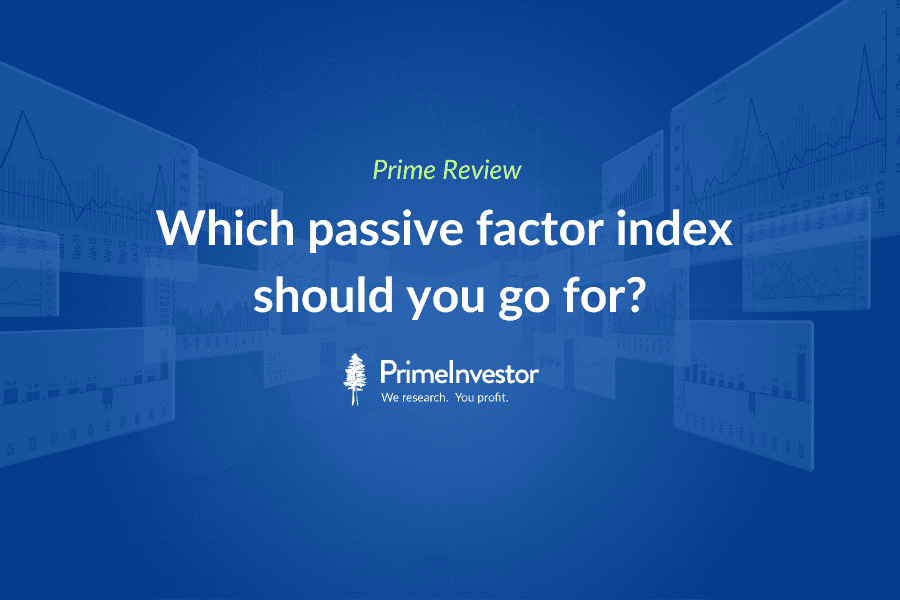A look at new launches in the mutual fund space will tell you that passive options are steadily increasing – and not just in the plain old Nifty 50 or Sensex! If you’ve taken a look at the index fund or ETF universe, chances are that you have come across funds with ‘low volatility’, ‘momentum’, ‘alpha’ and so on in their names.
These funds & ETFs track the factor indexes. Over the past few years, index funds and ETFs have been launched on several different types of indexes, ranging from mid-and-smallcap based to sectoral indexes to factor-based indexes.

This last type – factor indexes – are those that have caught the most attention, as they seek to deliver something different from the regular indices by focusing on key characteristics of a stock. So, what are these factors, what do they mean, which ones should you invest in, and how do you use them in your portfolio? Here are the answers.
The factors in a factor index
For those in the dark, a brief lesson on what factor indexes are!
Indices such as the Nifty 50 or Sensex are all built or weighted using a stock’s free-float marketcap (after considering elgibility criteria). These are market-cap indices. In a factor index, a main index like the Nifty 100/200 etc., or a universe of stocks that meet certain marketcap eligibility criteria, are taken. On these stocks, certain metrics are calculated. These metrics seek to assess a particular characteristic. This characteristic is termed a ‘factor’. In a factor index, a stock’s weight is based on its factor score.
The table below explains the main factors that are considered in indices currently.
A factor index can use a single factor or a combination of these. Further, most factor indexes have a parent index from which they are drawn which could be one index or a combination of indices.
Take the Nifty 100 Low Volatility 30 index. This is a single-factor index which takes the Nifty 100 index stocks and then calculates the volatility score for each. It takes the top 30 scores, and uses the score to assign the stock weights. On the other hand, the Nifty Alpha Low Vol 30 is a multi-factor index that scores both alpha and volatility for a stock. It also combines the Nifty 100 and the Nifty Midcap 50 index to form the stock universe on which the factor metrics are applied.
You can find the methodology explanation for each factor index for NSE indices here and BSE indices here.
Factor index performance
Combining ETFs and index funds there are today, you have about 57 that track about 20 factor indices. Apart from the factors discussed above, a popular index option that funds and ETFs have is equal weight – essentially, the index ignores the marketcap weight in an index and instead just assigns equal weights to all constituents.
When it comes to investing in factor indices, the following points need to be considered:
- What is the key characteristic of the index’s returns compared to the parent – is it able to contain downsides, deliver on upsides, more volatile or less and so on
- Is it able to beat the parent – this is the key question. If the factor index does not beat its parent with any consistency, then you’re better off simply sticking to the parent index especially if it does not display any especial ability to contain downsides or generate high returns.
On the two counts above, we looked at the performance of the factor indexes on which funds & ETFs are available today. Remember here that factor indices are a relatively new concept. Several of them have only a few years’ worth of real-time index calculation. This makes historical index data pre-launch a bit unreliable; it would present a perfect picture of sorts as the process of determining factor weights and calculations would ensure strong performance.
That said, here are the key trends that shape up.
#1 Consistency is poor
On the measure of consistency in beating the parent index or closest applicable benchmark, most factor indices are not consistent performers. That is, the factor index is not able to generate higher returns than the parent consistently. Any outperformance is usually only in spurts.
Let us take a few examples to understand the performance:
- The Nifty Alpha Low Vol 30 – which combines large & midcaps – beat the Nifty 500 less than 40% of the time on a 3-year rolling return basis.
- The Nifty 100 Low Vol 30 beats the Nifty 100 about 56% of the time on a rolling 3-year basis.
- Other factor indexes based on alpha and momentum have fared a bit better. The Nifty 200 Momentum 30 beat the Nifty 200 63% of the time on a rolling 1-year return basis. On a 3-year basis, this index sports a far higher consistency - but the index was launched only in August 2020, which gives limited room to gauge correct longer-term performance and markets have favoured a momentum strategy in the past few years.
- The Alpha 50 index, which combines the Nifty 100 and the Nifty 50 beats the Nifty 500 consistently on a 3-year basis but sports lower consistency compared to the plain old Nifty 50.
- Another index with a good degree of consistency is the Nifty 50 Value 20 – but then the index more or less captures the bulk of the Nifty 50 index, and its low financials weight has helped it beat the Nifty 50 about 80% of the time on a 1 year rolling return basis.
Consistency apart, factor indexes can fall more or be more volatile than their parent indexes – or then not deliver on upsides. Therefore, it is not necessary that all factor indices make good long-term additions to a portfolio. You need to be careful about which index you choose and you additionally need to avoid making these factor index funds a core part of your portfolio.
#2 Tactical plays are better
Certain factor indexes excel at performing in a particular market cycle. To this extent, if you’re able to gauge the nature of the market, these indices make good tactical additions to your portfolio.
For example, consider the Nifty 200 Momentum 30 – as explained above, the index is not very consistent on a 1-year basis. However, it excels at capturing upsides. Its upside capture ratio on 1-year returns is 126%. Its average 1-year gain rolled over the past 5 years stands at a good 32% compared to the Nifty 200’s 22%.
Similarly, the Nifty 500 Value 50 manages outstanding upside compared to the Nifty 500 index, with average gains at 49% compared to the 25% for the Nifty 500 for the rolling 1-year return period mentioned above. But the index can spectacularly crash as well! The same holds for the Nifty Alpha 50 index, which combines stocks from the Nifty 100 and the Nifty Midcap 50 indices.
Therefore, factor indices based on the following - value, alpha, momentum and equal weight – are ideally suited for tactical or strategic calls in your portfolio and can work very well if timed right. They do not need to be considered only as ‘long-term’ holdings.
#3 Quality is avoidable
It might seem strange but going by the performance of quality-based indexes, these are entirely skippable. Quality factor indices are neither able to generate strong upsides, nor display consistency in performance. While they may do well on the volatility front, this is not a significant aspect that works in their favour given their overall return.
For example, the average 3-year return of the Nifty 100 Quality 30 stands at about 13.3% in line with the Nifty 100, with its volatility only marginally lower. The same holds for the Nifty 200 Quality 30 or the Nifty Midcap 150 Quality 50.
Low volatility as a factor also does not work if returns alone are considered. These are certainly much lower in volatility than their parent and quality-factor indices and are true to their ‘low vol’ tag. The question is how much you would want to sacrifice in returns for the sake of lower volatility in a passive option. To put this in perspective, the Nifty 100 Low Vol 30 has at some points in the past 5 years trailed the Nifty 100 by 10-14 percentage points.
How to invest in a factor index fund
You have index funds and ETFs that are built on the different factor indices explained above. The key factor in passive options is the tracking error.
In index funds - where funds have a history, we rate them in Prime Ratings where tracking error is an important metric. Tracking error data is available in the MF Screener as well. Note that there are some indices where higher tracking error is a given; such as in midcap or smallcap based indices.
In ETFs - a key challenge is liquidity in addition to tracking error. Several indices have very poor trading volumes; you can check Prime ETF Ratings which will give you traded volume data as well as rating based on tracking error, expense ratio and so on. Go for ETFs where volumes are high. Also be wary of fund-of-funds investing in these ETFs as they will also suffer from the same limitations.
Where we view performance of a factor index to be consistent and useful longer-term additions, we add them to Prime Funds and Prime ETFs. We also provide Buy/Sell/Hold calls on index funds where they come into our rating, but please note that these calls are based on similar factors of consistency and relative performance; they are not tactical in nature.
Now, let’s move to pointers on how to use factor index funds in your portfolio:
- Ensure first that you have the primary market-cap based indices – Nifty 50/100/Sensex, Nifty 500 or Nifty Midcap 150 – as they represent the market, will automatically adjust for stock rallies or corrections. Any factor index needs to be only in addition to these and should never form the main part of your portfolio.
- Stick to NSE-based factor indexes; as far as we can judge based on data collected BSE factor indices are not able to beat the BSE LargeMidcap index (the parent index) on most metrics such as upside, volatility and consistency.
- If active funds are a big part of your portfolio, you don’t really need factor indices unless you want to further diversify. You’re already betting on active funds to give you that index-plus return or contain downsides and so on.
- If your portfolio is primarily passive, then adding on factor indices will be a good way to introduce market-beating options. In this case, you can diversify your portfolio by mixing a low-vol index option to contain downsides along with a high-returning alpha or momentum index to balance it out. Avoid multi-factor indices – use single factor indices so that you can control the allocation to indices that contain volatility or generate upside based on your risk and requirement.
- Bear in mind the marketcap allocation of the factor index – several of them will have exposure to midcap or smallcap stocks. Consider this in the high-risk allocation in your portfolio along with your normal mid/smallcap/multicap funds to ensure that you do not inadvertently raise the risk of your portfolio.






4 thoughts on “Prime Review – Which passive factor index should you go for?”
Thanks for the good article, Bhavana. Does Quant Momentum Fund quality as factor fund? It plays only on momentum factor and reasonably consistent in its performance. What is your analysis on Quant Momentum fund?
Also, would like to get your opinion on the strategy of the new ABSL Quant fund (they take top 75 companies from the portfolio of other MF companies and apply quality and volatility filters to arrive at around 50 companies to invest). Isn’t this a good strategy, at least to start with, since it still should show realtime performance?
Hello sir, Replying to this as I addressed the Quant Momentum question. On Quant funds, we have seen most of them thus far perform in narrow cycles. We would therefore need to watch live performance across market phases. Vidya
Nice article on ETF / Index fund evaluating merits as well as mention Nifty 50 Value 20 ‘s out performance about 80% , would like to have your view can Nifty 50 Value 20 be part of Value fund in a portfolio with reasonable allocation ?
We see that you have raised this query through a ticket and we have responded already there. – thanks, Bhavana